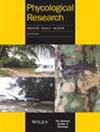Lithophyllum nagaokaense sp. nov. (Corallinales, Corallinophycidae, Rhodophyta): A new rhodolith-forming non-geniculate coralline alga from Japan
IF 1
4区 生物学
Q2 MARINE & FRESHWATER BIOLOGY
引用次数: 0
Abstract
Lithophyllum is a cosmopolitan coralline algal genus with 12 species currently recognized in Japan based on modern morpho-anatomical taxonomic concepts primarily characterized by having uniporate tetrasporangial and bisporangial conceptacles, the presence of secondary pit-connections between cells of adjacent filaments and a dimerous thallus construction with a single basal layer of predominantly non-palisade cells. In the present study, we describe Lithophyllum nagaokaense sp. nov. based on a combination of molecular and morpho-anatomical data of specimens from the temperate waters of Japan. The new species forms both attached epilithic thalli and free-living rhodoliths. Phylogenetic analyses of psbA, rbcL and COI markers resolved L. nagaokaense as an independent species. Morpho-anatomically, L. nagaokaense resembles Lithophyllum johansenii, originally described from Australia, but distinguished from the latter by the absence of enlarged angular cells occluding pore canals of tetrasporangial conceptacle chambers. Lithophyllum nagaokaense shared a fruticose morphology with Lithophyllum kaiseri, Lithophyllum kuroshioense, Lithophyllum neo-okamurae, Lithophyllum okamurae, and Lithophyllum pygmaeum from Japan. Of these, L. nagaokaense is the most similar to L. neo-okamurae in having attached and free-living thalli with encrusting and warty to lumpy growth forms bearing knobby protuberances that are dichotomously branched or anastomosing. The new species is distinct from other Japanese fruticose species collectively by five tetrasporangial conceptacle chamber characters and the absence of trichocytes. A taxonomic key for identifying Japanese fruticose species is provided. This is the fifth Lithophyllum species and the third rhodolith-forming species verified by DNA sequencing to be found in Japan.Lithophyllum nagaokaense sp:来自日本的一种新的菱形非基因型珊瑚藻
石蒜藻(Lithophyllum)是一种世界性珊瑚藻属,根据现代形态解剖学的分类概念,目前在日本有 12 个物种,主要特征是具有单孔四孢子囊和双孢子囊概念器,相邻丝状体细胞之间存在次生凹坑连接,以及具有单基底层主要为非鳞片状细胞的二孢藻体结构。在本研究中,我们根据日本温带水域标本的分子和形态解剖数据,描述了 Lithophyllum nagaokaense sp.该新种既能形成附着的附生苔藓,也能形成自由生活的菱形苔藓。通过对 psbA、rbcL 和 COI 标记的系统进化分析,发现 L. nagaokaense 是一个独立的物种。从形态解剖学上看,L. nagaokaense 与最初在澳大利亚描述的 Lithophyllum johansenii 相似,但与后者的区别在于没有扩大的角状细胞堵塞四孢子囊概念腔的孔道。Lithophyllum nagaokaense 与来自日本的 Lithophyllum kaiseri、Lithophyllum kuroshioense、Lithophyllum neo-okamurae、Lithophyllum okamurae 和 Lithophyllum pygmaeum 的形态相同。其中,L. nagaokaense 与 L. neo-okamurae 最为相似,都有附生和离生的叶柄,生长形式为包壳状、疣状或块状,带有二歧分枝或吻合的节状突起。该新品种与其他日本具缘毛的物种的共同特征是具有五个四孢子囊概念室,并且没有毛细胞。本文提供了一个用于鉴别日本飞蓬属物种的分类学检索表。这是日本发现的第五个石蒜属物种,也是通过 DNA 测序验证的第三个形成菱形石的物种。
本文章由计算机程序翻译,如有差异,请以英文原文为准。
求助全文
约1分钟内获得全文
求助全文
来源期刊

Phycological Research
生物-海洋与淡水生物学
CiteScore
3.60
自引率
13.30%
发文量
33
审稿时长
>12 weeks
期刊介绍:
Phycological Research is published by the Japanese Society of Phycology and complements the Japanese Journal of Phycology. The Journal publishes international, basic or applied, peer-reviewed research dealing with all aspects of phycology including ecology, taxonomy and phylogeny, evolution, genetics, molecular biology, biochemistry, cell biology, morphology, physiology, new techniques to facilitate the international exchange of results. All articles are peer-reviewed by at least two researchers expert in the filed of the submitted paper. Phycological Research has been credited by the International Association for Plant Taxonomy for the purpose of registration of new non-vascular plant names (including fossils).
 求助内容:
求助内容: 应助结果提醒方式:
应助结果提醒方式:


